Water Use in the West and the New Not-So-New Thinking About Our Landscapes
Written by Greg White, PLA, ASLA, SITES AP, DTJ Associate Principal + Landscape Architect.
Warm weather is upon us, the time of year when we get excited about the possibilities of a new project’s growth or have a renewed energy toward our home garden. But despite the beautiful weather, we find ourselves in an unprecedented time of change where future priorities are reevaluated every day. Having meaningful and relaxing outdoor experiences close to home has never been more important; well-designed landscapes are proving their value for many communities, as they provide a place to exercise and escape the stress of today’s world. These important spaces allow us to recharge, and inspire us to new ways of thinking.
 Now is the time to embrace a responsible and sustainable approach to community and residential landscape design – we live in the arid west and we need to embrace it as designers and constructors! The aesthetic of the west is rugged, dry, and beautiful, and we can create a vision of resilient and sustaining landscapes that will perform over time and bring ecological improvements to us all.
Now is the time to embrace a responsible and sustainable approach to community and residential landscape design – we live in the arid west and we need to embrace it as designers and constructors! The aesthetic of the west is rugged, dry, and beautiful, and we can create a vision of resilient and sustaining landscapes that will perform over time and bring ecological improvements to us all.
Conservation statistics show that urban watering is the single largest demand on most municipal supplies. For states such as Colorado and many major metro areas in the west, outdoor water use amounts to 50% of total household water use; the Arizona Department of Water Resources states the largest use of potable water in Arizona is for landscaping and as much as 70% of residential water use is outdoors. Millions of gallons are used annually to irrigate non-residential landscapes such as parks, golf courses, sport fields, and resorts. This could be drastically reduced by xeriscaping and efficient irrigation.
“Xeriscaping,” a term developed by the Front Range Xeriscape Task Force of Denver Water and trademarked by the City of Denver more than 40 years ago, combines the words xeros (Greek for dry) and landscape, and is a form of beautiful landscaping that eliminates the need for irrigation. Xeriscaping allows us to think bigger about ecological systems and perspectives for the future, providing a low maintenance and waterwise solution to outdoor spaces. However, xeriscaping is the baseline – we should push ourselves as designers to take it even further than that.

So, how do we do this?
We have been working on answers to this question for more than 20 years, and through this experience, we have outlined the top 5 ideas on how to move toward a regionally appropriate landscape solution that still looks great!
Lead the education. The only way we can change buyer and user perception is through education. If people understand the reason it looks the way it does they will more likely embrace a new aesthetic. Bike helmets are a great example of this – no one used to wear them and now everyone does and sees it as fashion accessory. We need to communicate in the public realm why we are doing it a certain way and the benefits for doing so. The collective movement can gain momentum if we have buy in from developers, builders, homeowners, and designers.

Ditch the lush lawn. We aren’t in the tropics. Water is a scarce resource, and prioritizing a visual preference is irresponsible with the current and trending water supply issues in the western region. Fortunately, there are many ground plane alternatives, such as hardy ground covers, decorative materials, and low maintenance native lawns that maintain their appeal while conserving water. Instead, save the real lawn for active use only, and take the proper installation steps to make it waterwise and minimize maintenance.

Embrace native or designed plant communities. We all want healthy places and spaces. We need to think about our impact on the environment at a local scale – are we impacting the water ways, air quality, or wildlife with our high input landscapes? A well-designed plant community is one that uses nature as a guide for the plants selected based on compatibility and adaptability to coexist. The approach also factors in visual preferences to perform and look good at the same time. The use of native or designed plant communities can have a measurable positive impact on our environment by cleaning and saving water, creating habitats, and cleaning our air.

Seek design solutions that require deeper understanding of site and ecological function. We must do our homework and gain the background that will allow us to use plants adapted for the region, and make site-specific selections considering soil, available moisture, wildlife and pollinator habitat, and other factors that influence species and combinations. Design drivers must be ecologically functional, aesthetically pleasing – we can have both! Design should consider layers, textures, and color within the context of a sustainable landscape – we must strive to create landscapes that match the site, take clues from native plants, and understand the true availability of water.

Intelligent irrigation. There is a wealth of great technology in this area. The concept of blasting water over huge areas of lawn is costly and impacts the environment. The investment in high tech irrigation controllers and systems will pay for itself, especially as water and tap fees continue to rise. Pushing for reclaimed water use, mandating drip irrigation and hydrozoning, and even planning for no irrigation at all for parts of your landscape can all contribute to saving not only water, but also big money in the long term.
Regional identity is critical – we should feel proud to create landscapes that acknowledge and celebrate the sense of place, as well as do our part in water and resource conservation. This mindset can be applied to all areas of the country. Understanding why we’re aiming toward this goal is extremely important for buyers and user perception and participation, and it will require education on our part, but we can and will get there.
We’re all in this together.
Let’s design for the present; let’s think to the future.


 BACK TO BLOG
BACK TO BLOG